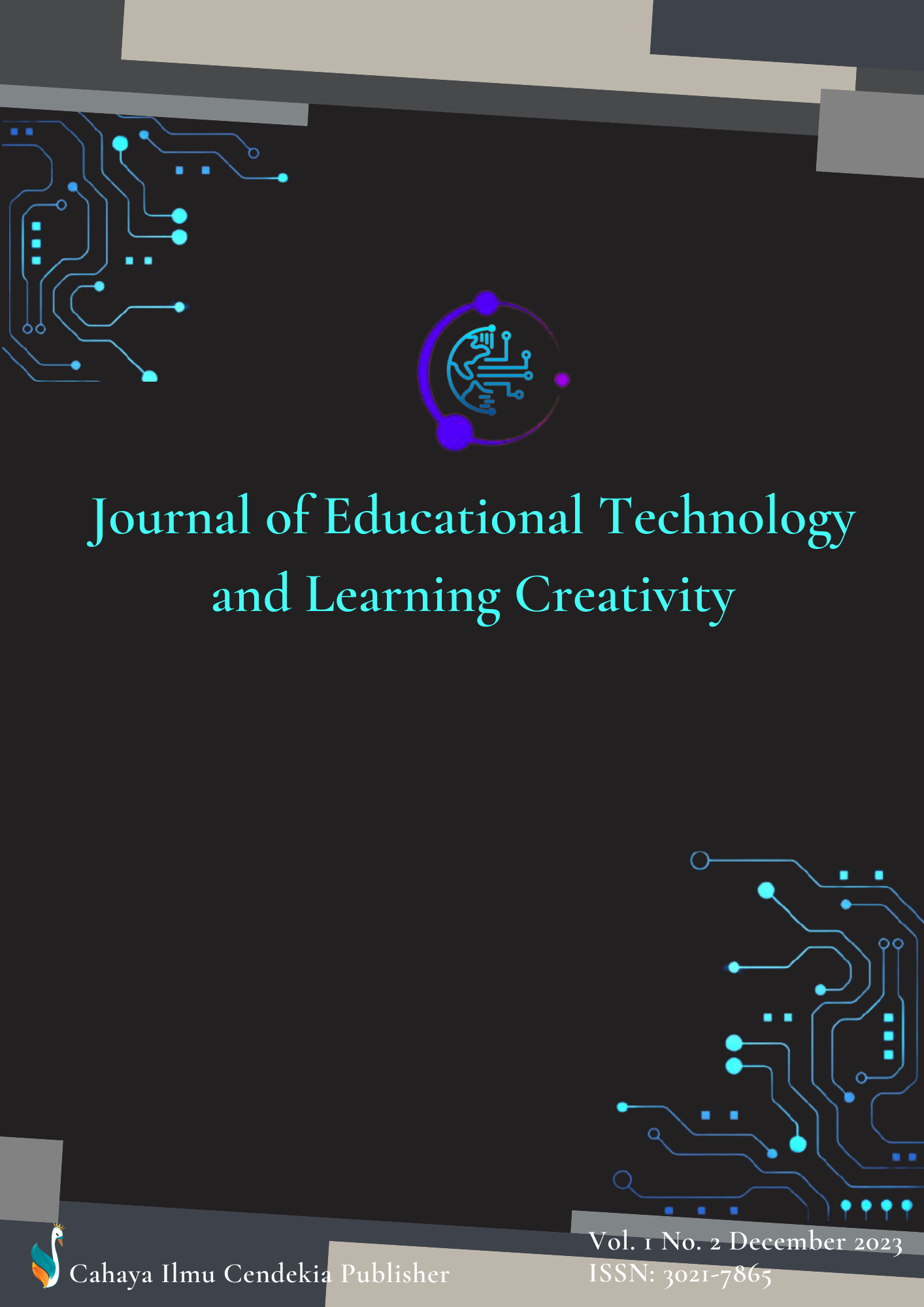Development of POE-Based Student Worksheets (Predict, Observe, And Explain) for Students' Mathematical Representation Abilities
Abstract
Purpose of the study: This research aims to evaluate students' worksheets for building flat-sided spaces based on POE as a learning tool in improving students' mathematical representation abilities. This research also aims to determine student and teacher responses to the use of the student worksheets that were developed.
Methodology: This research uses a 4D device development method which consists of four stages, namely the definition, design, development and dissemination stages. The development stage includes validation by material experts and media experts, revision, and testing of student responses. Data collection uses student response questionnaires using student worksheets to train students' mathematical representation skills. The subjects of this research were students in class VIII of junior high school. Data analysis techniques use descriptive statistics and qualitative analysis using the Miles and Huberman model.
Main Findings: The validation results of material experts and media experts show that the student worksheets developed are quite valid. This research found that the POE-based flat-sided space construction student worksheet is suitable for use in improving students' mathematical representation abilities and getting positive responses from students and teachers. This research contributes to the development of innovative and effective learning tools in the context of mathematics learning.
Novelty/Originality of this study: The novelty of developing a POE-based student worksheet for students' mathematical representation abilities lies in its departure from traditional teaching methods, its emphasis on inquiry-based learning and higher-order thinking, and its adaptability to a variety of mathematical topics all contributing to a more dynamic and engaging educational experience
References
D. Ilham, "Menggagas pendidikan nilai dalam sistem pendidikan nasional," Didaktika: Jurnal Kependidikan, vol. 8, no. 3, pp. 109-122, 2019.
B. Hermanto, "Perekayasaan sistem pendidikan nasional untuk mencerdaskan kehidupan bangsa," Foundasia, vol. 11, no. 2, 2020.
A. Kafifah, T. Sugiarti, and E. Oktavianingtyas, "Pelevelan kemampuan literasi matematika siswa berdasarkan kemampuan matematika dalam menyelesaikan soal PISA konten change and relationship," KadikmA, vol. 9, no. 3, pp. 75-84, 2018.
P. Fitriyani, “Pendidikan karakter bagi generasi Z,” Prosiding Konferensi Nasional Ke-7 Asosiasi Program Pascasarjana Perguruan Tinggi Muhammadiyah Aisyiyah (APPPTMA), Jakarta, pp. 23-25, 2018.
A. Noviardi, “Integrasi Nilai Pendidikan Iman Dan Ilmu Pengetahuan Dalam Tafsir Al-Misbah (Kajian Surat Al–Mujadilah 58: 11),” Andragogi: Jurnal Pendidikan Islam Dan Manajemen Pendidikan Islam, vol. 3, no. 3, pp. 367-377, 2021.
A. Muchlis, E. S. Komara, W. Kartiwi, N. Nurhayati, H. Hendriana, and W. Hidayat, "Meningkatkan koneksi matematis siswa SMP melalui pendekatan open-ended dengan setting kooperatif tipe NHT," Kalamatika: Jurnal Pendidikan Matematika, vol. 3, no. 1, pp. 81-92, 2018.
Halat, "The Impacts Of Mathematical Representation Developed Through Webquest and Spreadsheet Activities on the Motivation of Pre-service Elementary School Teachers," TOJET: The Turkish Online Journal of Educational Technology, vol. 10, no. 2, pp. 259-263, 2011.
Hwang et al., "Multiple Representation Skill and Creativity Effects on Mathematical Problem Solving Using a Multimedia Whiteboard System," Educational Technology & Society, vol. 10, no. 2, pp. 191-212, 2007.
Misel and E. Suwangsih, "Penerapan Pendekatan Matematika Realistik Untuk Meningkatkan Kemampuan Representasi Matematis Siswa," Metodi Didaktik, vol. 10, no. 2, 2016.
S. Ramziah, "Peningkatan Kemampuan Representasi Matematis Kelas X2 SMAN 1 Gedung Menang Menggunakan Bahan Ajar Matriks Berbasis Pendekatan Saintifik," Jurnal Pendidikan Matematika STKIP Garut, vol. 8, no. 3, 2016.
R. Sarumaha, D. Harefa, and M. M. Zagoto, "Upaya Meningkatkan Kemampuan Pemahaman Konsep Geometri Transformasi Refleksi Siswa Kelas XII-IPA-B SMA Kampus Telukdalam Melalui Model Pembelajaran Discovery Learning Berbantuan Media Kertas Milimeter," Jurnal Education and Development, vol. 6, no. 1, pp. 90-90, 2018.
C. L. N. Abadi & K. L. K. Malang, Model Discovery Learning dalam Pembelajaran Pendidikan Agama Islam dan Budi Pekerti di Sekolah, 2022.
R. Royani, "Penerapan Model Pembelajaran Predict-Observe-Explain (POE) Untuk Meningkatkan Motivasi Belajar
Fisika Siswa SMPN 1 Banda Aceh," Journal of Technology and Literacy in Education, vol. 1, no. 1, pp. 1-4, 2022.
H. Ozdemir, H. Bag, and K. Bilen, "Effect of Laboratory Activities Designed Based on Prediction, Observation, Explanation (POE) Strategy on Pre-Service Science Teachers’ Understanding of Acid-Base Subject," Western Anatolia Journal of Educational Science, pp. 170, 2011.
A. U. Dani and N. Hilwa, "Perbandingan Pemahaman Konsep Peserta Didik Melalui Pembelajaran POE dan Pembelajaran Inkuiri Bebas Termodifikasi," JPF (Jurnal Pendidikan Fisika) Universitas Islam Negeri Alauddin Makassar, vol. 8, no. 2, pp. 118-126, 2020.
F. M. Tahir, N. M. Nasri and L. Halim, “The Effectiveness of Predict-Observe-Explain-Animation (POE-A) Strategy to Overcome Students’ Misconceptions about Electric Circuits Concepts,” Learning Science and Mathematics, vol.1, no. 15, pp. 1-15, 2020.
R. D. Fanni, "Pengembangan Lembar Kerja Siswa (LKS) Berbasis POE (Predict, Observe and Explain) Pada Materi Program Linier Kelas XII SMA," Jurnal Sainmatika, vol. 8, no. 1, 2018.
U. Wiyatamal et al., "Pengembangan LKS berbasis POE (Predict, Observe, and Explain) pada Pokok Bahasan suhu dan Kalor Fisika SMA kelas X," in Prosiding SNIPS 2016, 2016.
Sugiyono, Metode Penelitian pendidikan kuantitatif, Kualitatif dan R&D, Bandung: Alfabeta, 2014, pp. 297.
R. Mesra, Research & Development Dalam Pendidikan, 2023.
L. Rismaini, D. Devita, and S. Dewimarni, "Effectiveness Of Basic Mathematics Teaching Materials Study Program In Informatics Engineering Education," Jurnal Ilmu Pendidikan Ahlussunnah, vol. 5, no. 2, pp. 154-161, 2022.
S. R. J. Djakadana, C. K. Ekowati, and M. Wangge, "Pengembangan Perangkat Pembelajaran Dengan Pendekatan Santifik Menggunakan Model 4-D pada Materi Koordinat Kartesius Untuk Siswa Kelas VIII SMPN 18 Kota Kupang," Haumeni Journal of Education, vol. 2, no. 2, pp. 35-46, 2022.
M. Tasnim, N. Azizah, S. R. Ningsih, M. D. Dahlan, And E. Erdisna, "Pengembangan Media Pembelajaran Kewirausahaan Dengan Metode 4-D Berbasis Digital Di Perguruan Tinggi," in Conference on Innovation and Application of Science and Technology (CIASTECH), vol. 5, no. 1, pp. 615-622, 2022.
F. A. Lubis and A. S. Sormin, "Pengembangan Modul Berorientasi Predict, Observe, Explain (Poe) pada Materi Virus terhadap Kognitif Siswa," Jurnal Biolokus: Jurnal Penelitian Pendidikan Biologi dan Biologi, vol. 2, no. 2, pp. 186-194, 2019.
R. Refianti and M. Luthfiana, "Pengembangan Lembar Kerja Siswa Menggunakan Pendekatan Matematika Realistik Indonesia Materi Persamaan Linear Dua Variabel di Kelas VIII," Jurnal Pendidikan Matematika: Judika Education, vol. 6, no. 1, pp. 38-45, 2023.
S. R. Hasanah, "Pengembangan e-module berbasis poe (predict, observe, explain) pada materi teori kinetik gas untuk siswa kelas xi di sma negeri 5 palangka raya," Doctoral dissertation, IAIN Palangka Raya, 2021.
U. Khasanah, "Pengembangan Lembar Kerja Siswa (LKS) Berbasis Inkuiri Terbimbing Berbantuan Media Grafis Pada Mata Pelajaran Matematika Kelas VIII MTs Al-Hikmah Bandar Lampung," Skripsi, 2016, pp. 80.
G. Sari, M. Hasan, and M. Mahidin, “The development of student worksheet based on predict observe explain to increase students’ conceptual understanding of the reaction rates,” IOP Conf. Series: Journal of Physics: Conf. Series 1460, pp. 1-7, 2020.
Copyright (c) 2023 Eka Nur Setiyani, Zain Hazmi Zain Baharin, Samuel N. Jesse

This work is licensed under a Creative Commons Attribution-NonCommercial 4.0 International License.
Authors who publish with this journal agree to the following terms:
- Authors retain copyright and acknowledge that the Journal of Educational Technology and Learning Creativity is the first publisher licensed under a Creative Commons Attribution 4.0 International License.
- Authors are able to enter into separate, additional contractual arrangements for the non-exclusive distribution of the journal's published version of the work (e.g., post it to an institutional repository or publish it in a book), with an acknowledgment of its initial publication in this journal.
- Authors are permitted and encouraged to post their work online (e.g., in institutional repositories or on their website) prior to and during the submission process, as it can lead to productive exchanges and earlier and greater citation of published work.


.png)


.png)
.png)
.png)












